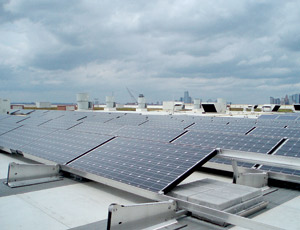Swedish home-furnishings giant IKEA officially powered up its Brooklyn, N.Y., store’s rooftop solar system this spring after several delays, including a mid-construction switch of its main contractor.

The store is one of four worldwide participating in a $11.7-million pilot program IKEA established in 2009 with Loughborough University, Leicestershire, U.K., and the now-defunct contractor Perpetual Energy Ltd., Knutsford, U.K., to monitor and evaluate performance of photovoltaic systems. While the systems at each of the four sites are operational, their monitoring capabilities are as yet limited as IKEA and the university’s Centre for Renewable Systems Technology work out program and partnership details, according to a source close to the deal.
The Brooklyn site’s 200-kW system, which the retailer calls one of the largest commercial rooftop installations in New York City, consists of four types of modules that generate 240,000 kW hours/year of electricity—comparable to other pilots at Ghent, Belgium; Rostock, Germany; and Seville, Spain, IKEA says.
Months after Perpetual Energy started work in Brooklyn in fall 2009, the contractor went out of business, according to U.K. corporate documentation. “They weren’t educated on contractual and legal issues and in dealing with contractors in the U.S.,” says Mark Gasper, IKEA’s U.S. energy manager.
That left IKEA with a “no-brainer” decision to make Perpetual Energy’s Brooklyn-based subcontractor Solar Energy Systems the new prime contractor, says Gasper. SES, the local certified installer for the project under the New York State Energy Research and Development Authority, acted as a design and installation consultant during the installation, says David Buckner, SES president. “We designed the system and wrote the bid spec for the electrical contractors,” Buckner says. SES will maintain the system for IKEA for five years, he adds.
“We were comfortable with SES early on and had tried to have them involved more intimately in the construction,” Gasper says.
“We had the final sign-off from Con Ed for interconnection of the system in September 2010, and shortly after that we started generating some power,” he says.
Combined, the modules provide only about 4% of the Brooklyn store’s total electricity demand, Gasper says. “This is really a small-scale test of PVs,” he says, adding that the size of the systems for each store in the pilot program is about the same.
The Brooklyn PV modules are from four manufacturers: SunTech’s polycrystalline solar panels, Solar Integrated Technologies’ amorphous thin-film laminates, Yingli Solar’s polycrystalline silicon panels and Sanyo’s monocrystalline-amorphous hybrid modules.
Unlike most PV installations that use a central converter, the Brooklyn arrays have 24 smaller inverters to monitor two strings—about 12-14 modules connected in series—at a time, Gasper says. The configuration provides better data on PV performance, he adds.
Background Checks
IKEA has learned a few lessons from the Brooklyn pilot project, Gasper says. “My advice would be to put a lot of effort into due diligence and preplanning to ensure you find the right partner—on the knowledge and experience side, from a financial perspective and from a local experience perspective,” he says.
“The solar market is hot now and has been for a while, so there are numerous solar contractors,” which reinforces the need for due diligence, he says, adding that, so far, there is no guidance on best practices for systems owners.
Meanwhile, IKEA last month started up its largest installation to date, a 1.8- MW system at a Tejon, Calif., site. Designed and installed by San Luis Obispo, Calif.-based REC Solar, the 370,000-sq-ft array will generate 2.88 million kW/h of power annually. REC Solar also is heading up solar installations at IKEA’s Paramus, N.J., and Stoughton, Mass., sites. The company declined to provide project costs.



Post a comment to this article
Report Abusive Comment